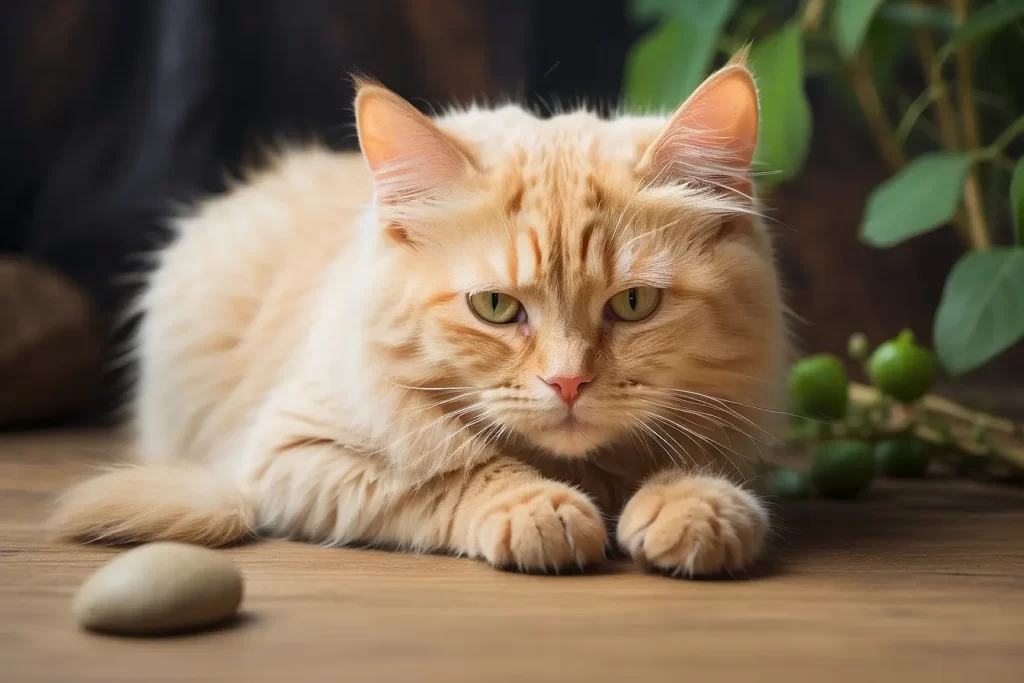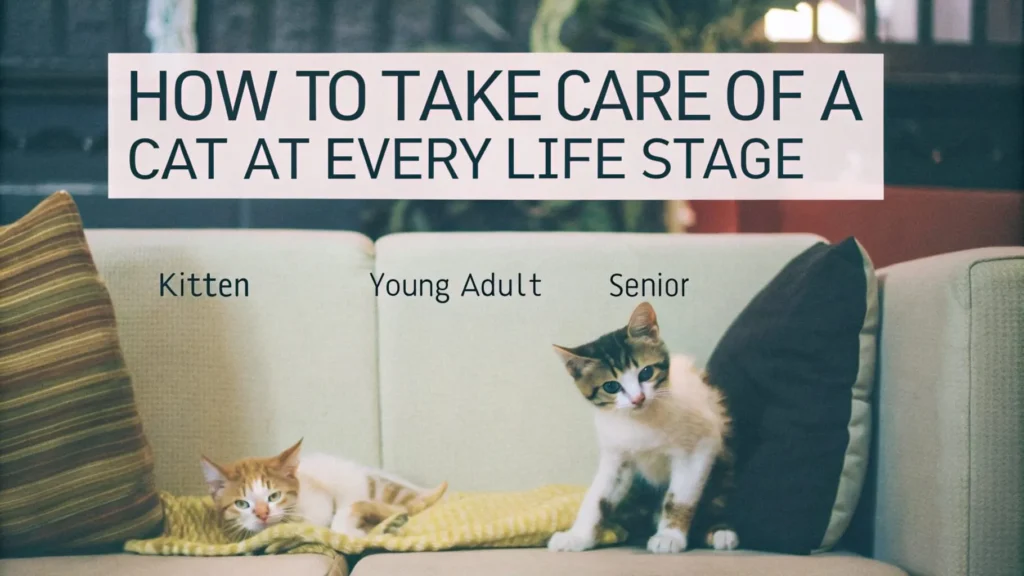Taking care of a cat involves understanding their needs and creating a safe environment for them to thrive. By providing the right care, you can ensure that your feline companion leads a happy and healthy life.
Understanding Your Cat’s Needs
Understanding your cat’s needs is essential for providing appropriate care. Cats are independent creatures with unique personalities, and their needs may vary. Some key aspects to consider include:
- Feeding: Cats require a balanced diet that meets their nutritional needs. Consult with your veterinarian to determine the best feeding schedule and the right type of food for your cat. Cat nutrition and diet is an important aspect to consider.
- Hydration: Ensure that your cat always has access to fresh water. Some cats prefer running water, so a cat water fountain may be a good investment.
- Grooming: Regular grooming is important to keep your cat’s coat healthy and reduce shedding. Brushing their fur, cleaning their ears, and trimming their nails are all necessary tasks. Cat grooming tools can assist in this process.
- Litter Box: Providing a clean and easily accessible litter box is crucial. Scoop the litter box daily and completely change the litter at least once a week. Consider using natural cat litter and litter box odor control products to maintain a fresh environment.
- Safe Space: Cats need a designated space where they can retreat and feel safe. This can include a cozy bed, a cat tree, or a quiet corner of the house. Cat scratching trees can be a great addition to creating a cat-friendly home.
Creating a Safe Environment
Creating a safe environment is crucial for your cat’s well-being. Consider the following:
- Indoor Safety: If you keep your cat indoors, ensure that windows and balconies are secured to prevent accidents. Remove toxic plants and keep harmful substances, such as cleaning products and medications, out of reach.
- Cat-Proofing: Cats are curious creatures and may get into mischief. Secure electrical cords, keep small objects out of reach, and use cat scratching deterrents to protect your furniture.
- Enrichment: Cats need mental and physical stimulation. Provide a variety of toys, such as interactive cat toys and catnip toys for cats, to keep them engaged. Creating vertical spaces, such as shelves or cat scratching boards, allows them to climb and explore.
- Regular Veterinary Care: Schedule regular check-ups with a veterinarian to ensure your cat’s health. Vaccinations play a vital role in preventing diseases, so follow the appropriate kitten vaccination schedule for young cats and the cat vaccination schedule for adult cats.
By understanding your cat’s needs and creating a safe environment, you can provide the care and attention necessary for their well-being.
Remember to consult with a veterinarian for personalized advice based on your cat’s specific requirements.
Cat Health and Wellness
Ensuring the health and wellness of your cat is of utmost importance. This section covers key aspects of cat health, including vaccinations, common cat diseases, and maintaining a healthy weight.
Vaccinations for Cats
Vaccinations play a crucial role in protecting your cat from various diseases. It’s important to consult with a veterinarian to determine the specific vaccination needs of your cat based on its circumstances (PetMD).
Core vaccines, which include rabies, feline panleukopenia virus (FPV), feline herpesvirus-1 (FHV-1), and feline calicivirus (FCV), are essential for preventing serious and potentially fatal diseases (VCA Hospitals).
The vaccination schedule for cats typically begins at 6-8 weeks of age and continues at regular intervals until the kitten is 16 weeks old. After this initial series, booster shots are needed to maintain immunity. Rabies vaccination is required by law in most states and helps protect cats from this deadly viral disease that can also be transmitted to humans (VCA Hospitals).
It’s important to note that vaccination needs may vary based on factors such as geographical location and lifestyle. Consult with your veterinarian to develop a vaccination plan tailored to your cat’s specific needs.
Common Cat Diseases
Cats are susceptible to various illnesses, and being aware of common cat diseases can help you identify potential health issues early on. Some common cat diseases include urinary tract infections, kidney disease, diabetes, dental disease, and upper respiratory infections (The Drake Center).
Regular check-ups with a veterinarian and keeping an eye out for changes in behavior or physical symptoms can help detect these diseases and ensure prompt treatment.
Maintaining a Healthy Weight
Maintaining a healthy weight is crucial for your cat’s overall well-being. Excess weight can lead to various health problems, such as arthritis and other illnesses (Preventive Vet).
To help your cat maintain a healthy weight, it’s essential to provide a balanced diet and monitor their food intake. Feeding amounts can vary depending on factors such as age, size, activity level, and overall health status (Preventive Vet).
Consult with your veterinarian to determine the appropriate daily caloric intake for your cat’s life stage.
As a general guideline, a growing kitten may require about 300 to 500 calories per day, while adult and senior cats may need approximately 20 calories per pound of body weight (45 calories/kg of body weight) per day (Preventive Vet).
Feeding your cat a balanced and nutritionally complete cat food, such as grain-free cat food, can help ensure they receive the necessary nutrients while managing their weight.
In addition to a healthy diet, regular exercise is essential for maintaining a healthy weight. Providing opportunities for play, such as interactive cat toys and play sessions, can help keep your cat active and engaged. Consult with your veterinarian regarding an appropriate exercise routine for your cat’s specific needs.
By staying up to date with vaccinations, being aware of common cat diseases, and helping your cat maintain a healthy weight, you can ensure the overall health and wellness of your feline companion. Regular veterinary check-ups and open communication with your veterinarian are vital in providing the best possible care for your cat.
Feeding and Nutrition

Proper feeding and nutrition play a vital role in ensuring the health and well-being of your cat. Understanding the basics of cat nutrition and making informed choices about their diet is essential for providing them with the nutrients they need at every life stage.
In this section, we will explore cat nutrition 101, choosing the right cat food, and feeding guidelines for cats.
Cat Nutrition 101
Cats are obligate carnivores, which means they have evolved to require a diet high in animal protein. Their bodies are designed to efficiently process and utilize nutrients from animal tissues.
Protein is an essential macronutrient for cats as it provides the building blocks for strong muscles, healthy skin, and a shiny coat. It is important to feed them high-quality commercial cat food that contains a sufficient amount of animal protein to meet their nutritional needs (VCA Hospitals).
While cats require protein, they also need a balance of other essential nutrients such as fats, carbohydrates, vitamins, and minerals. These nutrients are necessary for maintaining overall health, supporting the immune system, and promoting optimal organ function.
It is recommended to feed your cat a complete and balanced diet that meets the standards set by reputable pet food organizations to ensure they receive all the necessary nutrients in the right proportions.
Choosing the Right Cat Food
When it comes to choosing cat food, there are various options available, including dry kibble, wet canned food, and raw food diets. Each type has its advantages and considerations.
Dry kibble is convenient and can help maintain dental health, while wet canned food provides hydration and may be more palatable for some cats. Raw food diets aim to mimic a cat’s natural diet but require careful handling and preparation to ensure safety.
Regardless of the type of cat food you choose, it is important to prioritize quality. Look for high-quality cat foods that list animal protein as the primary ingredient. Avoid cat foods that contain excessive fillers, artificial additives, or by-products.
Grain-free cat food has gained popularity in recent years, but it is important to note that cats can tolerate grains as part of a balanced diet. Always consult with your veterinarian to determine the most suitable cat food for your pet’s specific needs.
Feeding Guidelines for Cats
Establishing a feeding routine and following appropriate feeding guidelines is essential for maintaining your cat’s health. The specific feeding guidelines may vary depending on your cat’s age, weight, activity level, and any underlying health conditions.
Kittens have different nutritional needs compared to adult cats, so it is important to follow a kitten vaccination schedule and consult with your veterinarian for specific feeding recommendations.
As a general guideline, it is recommended to feed adult cats two to three small meals per day or leave out a measured amount of dry food for free feeding. However, it is important to monitor their food intake to prevent overeating and obesity.
Obesity is a common issue in cats and can lead to various health problems. If your cat is overweight, your veterinarian may recommend a weight-loss diet or adjusting the portion size to help them reach a healthier weight.
Remember, providing fresh and clean water at all times is crucial for your cat’s hydration. Cats have a low thirst drive, so wet food can be beneficial in increasing their water intake. Regularly clean and refill your cat’s water bowl to ensure they have access to clean water throughout the day.
By understanding the basics of cat nutrition, making informed choices about cat food, and following appropriate feeding guidelines, you can ensure that your cat receives a balanced diet that supports their overall health and well-being.
Consulting with your veterinarian for personalized advice is always recommended to meet your cat’s specific nutritional needs.
Grooming Your Cat
Proper grooming is an essential aspect of cat care. Regular grooming not only helps to keep your cat’s coat healthy and beautiful but also provides an opportunity for you to bond with your feline friend.
In this section, we will explore the key aspects of grooming, including bathing and brushing, nail trimming and dental care, as well as ear and eye care.
Bathing and Brushing
Unlike dogs, cats are generally good at grooming themselves and do not require frequent baths. However, there are situations when a bath may be necessary, such as when your cat gets into something dirty or smelly.
It is important to use a cat-specific shampoo that is gentle on their skin. When bathing your cat, follow these steps:
- Prepare a warm and quiet bathing area, such as a sink or a small tub.
- Gently wet your cat’s fur using a spray hose or a container with lukewarm water.
- Apply a small amount of cat shampoo and lather it into your cat’s fur, avoiding the face.
- Rinse thoroughly to remove all the shampoo, ensuring no residue is left behind.
- Use a soft towel to gently dry your cat, or allow them to air dry in a warm, draft-free area.
Regular brushing is also important to prevent matting and hairballs in cats. Brushing your cat’s fur at least once a week can help remove loose hair and prevent it from forming mats. This can also reduce the chances of your cat ingesting hair and developing hairballs.
Use a cat-specific brush or comb suitable for your cat’s fur type. Remember to be gentle and provide positive reinforcement during the grooming session.
Nail Trimming and Dental Care
Regular nail trimming is essential for a cat’s health and well-being. Overgrown nails can cause discomfort and lead to problems like ingrown nails or joint issues. It is recommended to trim your cat’s nails every 2-4 weeks using cat-specific nail clippers or a grinder. Here’s how you can trim your cat’s nails:
- Find a quiet and well-lit area where you can comfortably handle your cat.
- Gently hold your cat’s paw and press the pad to extend the claws.
- Use the clippers or grinder to carefully trim the sharp tip of each nail, being cautious not to cut the quick (the pink area inside the nail).
- If your cat becomes anxious or stressed during the process, take breaks and provide treats or praise to keep them calm.
Dental care is another important aspect of maintaining your cat’s overall health. Regular brushing of your cat’s teeth can help prevent dental issues such as tartar buildup and gum disease.
Use a cat-specific toothbrush and toothpaste, as human products can be harmful to cats. If your cat does not tolerate brushing, there are alternative options such as dental treats or water additives that can help promote oral hygiene.
Consult your veterinarian for recommendations based on your cat’s specific needs.
Ear and Eye Care
To ensure your cat’s ears and eyes remain healthy, it is important to pay attention to these areas during grooming sessions. Regularly check your cat’s ears for signs of infection, such as redness, discharge, or a foul smell.
Clean the ears gently with a cat-specific ear cleaner and a cotton ball or a soft cloth. Avoid inserting anything deep into the ear canal, as it can cause injury.
Similarly, keep an eye on your cat’s eyes and look out for any redness, discharge, cloudiness, or other abnormalities. If you notice any issues, consult a veterinarian for a thorough examination and appropriate treatment. Regularly wiping the eye area with a damp cloth can help remove any debris or discharge.
By incorporating regular bathing and brushing, nail trimming and dental care, as well as ear and eye care into your cat’s grooming routine, you can help keep them clean, healthy, and comfortable.
Remember to be patient and gentle during grooming sessions, providing positive reinforcement and making it a positive experience for both you and your feline companion.
Providing Enrichment
Cats are curious and active creatures, and providing them with the right environment and enrichment activities is essential for their overall well-being and happiness. In this section, we will explore different ways to create a cat-friendly home, engage them with toys and interactive play, and offer vertical spaces for exploration.
Creating a Cat-Friendly Home
To ensure that your cat feels safe and secure in their environment, it’s important to create a cat-friendly home. This involves providing designated spaces for them to retreat to, such as a cozy bed or a cat tree (4 Paws Animal Hospital). These spaces offer comfort and security, allowing your cat to relax and observe their surroundings.
Another important aspect of a cat-friendly home is providing appropriate scratching surfaces. Cats have an instinct to scratch, and by offering them scratching posts or boards, you can redirect their behavior away from your furniture (4 Paws Animal Hospital).
Scratching surfaces should be sturdy, tall, and covered in materials that mimic tree bark or sisal rope, as these textures are appealing to cats.
Toys and Interactive Play
Cats are hunters by nature, and engaging them in interactive play mimics their instinctual behavior and provides mental and physical stimulation.
Offering a variety of toys and interactive playtime can help keep your cat entertained and prevent boredom (4 Paws Animal Hospital). Consider toys with feathers, balls, or puzzles that dispense treats, as these can keep your cat engaged and mentally stimulated.
Interactive play with your cat not only strengthens the bond between you and your pet but also provides them with much-needed exercise.
Spend time playing with your cat using wand toys or laser pointers, allowing them to chase and pounce on the moving target. Remember to rotate toys regularly to maintain your cat’s interest and prevent them from becoming bored.
Vertical Spaces for Exploration
Cats are natural climbers and enjoy being in high places. Creating vertical spaces in your home can provide your cat with additional areas to explore and survey their surroundings (4 Paws Animal Hospital). Install shelves or provide cat perches and cat trees that allow your cat to climb and perch at different heights.
This not only satisfies their instinct but also provides them with a sense of security and a vantage point to observe their territory.
Vertical spaces can also be used to create a multi-level environment, especially in homes with limited floor space. This allows your cat to have a designated space for sleeping, playing, and relaxing, while also providing them with opportunities for exercise and mental stimulation.
By creating a cat-friendly home, offering toys and interactive play, and providing vertical spaces for exploration, you can ensure that your cat’s physical and mental needs are met. These enrichment activities contribute to a happy and healthy feline companion.
Remember to observe your cat’s preferences and adjust the enrichment activities accordingly to cater to their individual needs and preferences.
Cat Care FAQs
As a responsible cat owner, it’s natural to have questions about the care and well-being of your feline companion. In this section, we will address some frequently asked questions regarding cat care.
How Much Should I Feed My Cat?
Feeding your cat the right amount of food is essential for maintaining their overall health and weight. The recommended daily caloric intake for a cat depends on factors such as age, weight, activity level, and any underlying health conditions.
It’s best to consult with your veterinarian to determine the appropriate portion size for your cat’s specific needs.
To get a general idea of the recommended daily feeding guidelines, refer to the table below:
| Cat Weight | Daily Caloric Intake |
|---|---|
| 5 pounds | 180 – 200 calories |
| 10 pounds | 280 – 320 calories |
| 15 pounds | 380 – 420 calories |
Keep in mind that these are approximate values, and individual cats may have unique dietary requirements. It’s important to monitor your cat’s body condition and adjust their food intake accordingly.
For more information on cat nutrition and diet, refer to our article on cat nutrition and diet.
How Often Should I Vaccinate My Cat?
Vaccinations are crucial for protecting your cat against various diseases and ensuring their long-term health. The vaccination schedule for cats typically starts when they are kittens and continues throughout their adult life.
The core vaccines for cats include rabies, feline panleukopenia virus (FPV), feline herpesvirus-1 (FHV-1), and feline calicivirus (FCV).
The vaccination schedule for kittens usually begins at 6-8 weeks of age and continues at regular intervals until they are around 16 weeks old. After this initial series, booster shots are needed to maintain immunity.
The rabies vaccine is required by law in most states for cats, and it helps protect both cats and humans from this deadly viral disease.
To ensure your cat receives the appropriate vaccinations at the right time, consult with your veterinarian. They will create a personalized vaccination plan based on your cat’s age, lifestyle, and risk factors.
For more information on kitten vaccination schedules and cat vaccination guidelines, refer to our articles on kitten vaccination schedule and cat vaccination schedule.
How to Recognize Signs of Illness in Cats?
Cats are susceptible to various illnesses, and it’s important to be vigilant about their health. Recognizing the signs of illness early on can help you seek veterinary care promptly and prevent potential complications. Here are some common signs of illness to watch out for:
- Changes in appetite or water intake
- Weight loss or gain
- Lethargy or decreased activity level
- Changes in litter box habits
- Vomiting or diarrhea
- Coughing, sneezing, or difficulty breathing
- Increased thirst or urination
- Limping or difficulty moving
- Changes in behavior or mood
If you notice any of these signs or any other unusual behaviors or symptoms, it’s important to consult with your veterinarian. Prompt veterinary care can help diagnose and treat any underlying health issues. For more information on common cat illnesses and how to care for a sick cat, refer to our article on cat health and wellness.
By addressing these frequently asked questions, we hope to provide you with valuable insights into cat care.
Remember, each cat is unique, and it’s important to tailor their care to their individual needs. Regular veterinary check-ups, a balanced diet, and a loving environment are key to keeping your cat happy and healthy.



